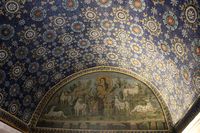Mosaics and World Heritage Site
Unique art
Romans, Ostrogoths, Langobards – there are few Italian places where the Migration period is as tangible as in Ravenna. The Emilia-Romagna city is known all over the world for its mosaics. Eight buildings intrinsically tied to this technique of painting known since antiquity were declared World Heritage Site by the UNESCO 1996. These are:
- Basilica di San Vitale
- Mausoleo di Galla Placida
- Basilica di Sant'Apollinare Nuovo
- Mausoleo di Teodorico
- Battisterio degli Ariani
- Battisterio Neoniano
- Capella e Museo Arcivescoville
- Basilica di Sant'Apollinare in Classe
Five of these monuments – Basilica di San Vitale, Mausoleo di Galla Placida, Battisterio Neoniano, Basilica di Sant'Apollinare Nuovo, and Capella e Museo Arcivescoville – can be visited at a special discounted rate of € 9.50 (every day 9 am to 7 pm) with the combined ticket Biglietto di ingresso cumultativo.
Censorship and Iconoclastic Controversy
Compared to many other mosaics and works of art of this era, the Ravennese mosaics managed to survive the Byzantine Iconoclastic Controversy fairly unharmed. Censorship still affected them, because Theoderic the Great, like almost all other members of the various Germanic tribes, belonged to Arianism, which was deemed heresy by the sovereigns of the Eastern Roman Empire. The Byzantine regent Justinian II ordered the correction or elimination of all depictions of Teoderic. Among these corrections is a mosaic right of the altar in Basilica di Sant'Apollinare Nuovo from which the Ostrogoth king and his entourage were extinguished.



Tweet